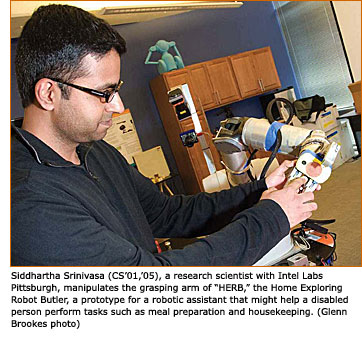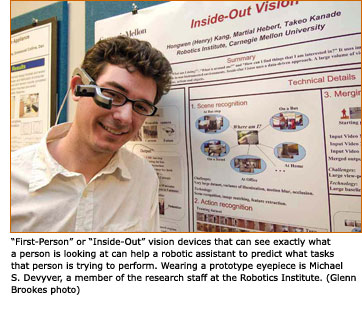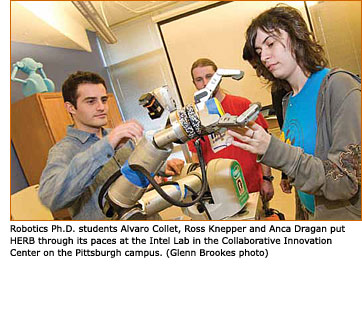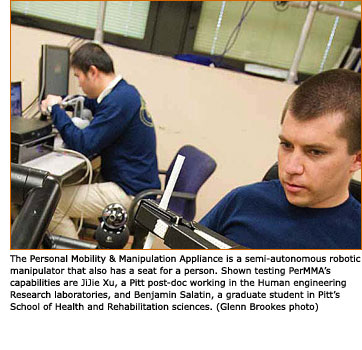
- Pittsburgh's Quality of Life Technology Center is solving the human-machine equation and spawning a new industry in the process.
"Quality of life." It's one of those stubbornly vague terms that are hard to define. For some people, having a good "quality of life" might mean getting a job that allows them to spend lots of time with family. For others, good "quality of life" might mean a certain possession, like a luxurious home.
But for someone with limited mobility--a veteran with a missing limb, a car-crash survivor, an older person with severe arthritis--having a high "quality of life" is a lot simpler. It's about getting dressed in the morning, navigating the kitchen and going to work or school.
Yet hundreds of thousands of Americans every day face the prospect of becoming dependent on people or machines due to age-related illnesses or conditions. According to the U.S. Centers for Disease Control and Prevention, about 1.5 million people reside in skilled nursing facilities, and about 88 percent of them are age 65 or older. Another 76 million Americans born during the so-called "Baby Boom" of 1946 to 1964 are starting to reach retirement age.
Conditions related to aging aren't the only thing that can make simple, everyday tasks more difficult or force someone into an assisted-living facility. About 250,000 Americans are living with spinal cord injuries, according to the National Institutes of Health, while 2.2 million veterans have a service-related injury, reports the U.S. Bureau of Labor Statistics.
It's a strange dichotomy that technologists like Jim "Oz" Osborn (E'81,'86), longtime researcher and scientist in the Robotics Institute, have watched with frustration. At the same time that computers were making the world smaller and robots were exploring other planets, millions of other people were watching their lives shrink to just one small room.
If computers can run the anti-lock braking systems on our cars and put streaming video on our cell phones, why can't they make sure that an elderly person is receiving his medication?
If robots can navigate Three Mile Island or the surface of Mars, why can't they find their way around a suburban bedroom?
Shouldn't technology be able to address "quality of life"?
The Quality of Life Technology Center aims to answer those questions. Founded in 2006 as a joint project of Carnegie Mellon and the University of Pittsburgh, it's merged CMU's leadership in developing and deploying robotics and sensor technology with Pitt's excellence in health care and rehabilitation sciences. The QoLT is one of five Engineering Research Centers in biotechnology and health care that's recognized and funded by the National Science Foundation. The center receives $4 million annually from the NSF and was recently awarded a three-year, $1.5 million NSF Innovation Award to get "quality of life technology" into the hands of people who need it as quickly as possible.
Highly interdisciplinary, the QoLT draws on the talents of roboticists, computer scientists, engineers, industrial designers, psychologists, social scientists and other researchers at both universities. Its commercialization counterpart, the Quality of Life Technology Foundry, has already spun off three companies based on ideas created at CMU and Pitt, says Rick McCullough, Carnegie Mellon vice president for research and former dean of the Mellon College of Science. With the new funding, he says, "we envision even greater success."
"Everybody wants to live independently, enjoy their life, feel secure," says Osborn, who serves as executive director of the Quality of Life Technology Center. "Robots have taken us into outer space, under the sea and into places too dangerous to go. QoLT gives us the opportunity to merge these technologies into rehabilitation and geriatrics--and at the same time spawn a new industry."
In various stages of development at QoLT are more than 20 assistive devices and systems ranging from things as simple as a computer application called "Lean and Zoom" that automatically zooms a computer screen in response to its viewer's body movements; to a full-scale assistive home that allows persons of limited abilities to live independently.
And thanks to its new funding, the QoLT Foundry is expanding its efforts to accelerate the new-product commercialization process by looking for broader consumer possibilities for assistive technology. "In the past, the typical assistive device has been produced in very limited quantities and paid for by the government," says Curt Stone, director of the QoLT Foundry. "We're trying to develop a business model where large consumer demand results in higher production and lower pricing, so consumers can pay for these products on their own."
For instance, a vest designed to allow people with hearing impairments to enjoy music by means of vibration has morphed into a consumer product called "VibeAttire." It allows the wearer to "feel" the music from an iPod, MP3 player or any other handheld audio device.
Integrating "man" and "machine" requires finesse, says Takeo Kanade, director of the QoLT Center and Carnegie Mellon's U.A. and Helen Whitaker University Professor of Computer Science and Robotics. "Until now, the key goal of robots has been to reduce human involvement," he says. "However, I don't think people want to live with robots that do everything for them."
For Kanade, the "magic equation" of a quality of life technology system is solved by taking what a person wants to do, and subtracting what he or she can do. "The difference between desire and ability is what the machine should provide," he says. "In my mind, human 'quality of life' is the (ability) to live as independently as possible--to do what we can do for ourselves, rather than having it done by other people or machines."
The practical and technical challenges associated with solving that equation are daunting, Kanade says. "One of the key components of quality of life technology is to understand what the user wants," he says. "Because unless a machine understands what its user wants, it cannot help. The machine system and the human being must work together to make a better system. We call that a human-system symbiosis."
QoLT has reduced the problem of symbiosis between people and machines to four research thrusts:
- Living a Life: The Person and Society
- Knowing the Person: Perception and Awareness
- Using the Machine: The Human-System Interface
- Interacting With the World: Mobility and Manipulation
Some of the interfaces that users might deploy are as familiar as keypads, joysticks and touch-screen monitors. Others are more unusual. Take the visual recognition system called "First-Person Vision" being developed by a team led by Kanade and Robotics Institute professor Martial Hebert.
"First-Person Vision" uses a pair of tiny, eyeglass-mounted cameras to allow a computer to "see" whatever the person wearing the glasses is looking at. The first camera uses a wide-angle lens to look at the full field of human vision, while the second uses a close-up lens to examine the user's eye and pinpoint the exact area he or she is looking at. From that composite result, the computer can determine what the user's intentions are.
When a user is looking at a can of soup on a kitchen counter, for instance, the computer can guess that the user needs it. If the computer is controlling a robotic arm, it can reach out for that can and bring it back for the user.
"If a computer has access to a user's field of view and area of interest, it will have a much easier time knowing what he or she is doing and thinking," says Kanade, acknowledged as one of the world's leading experts in computer vision--the science of enabling computers to see and interact with their environments. "First-Person Vision" is one of the biggest steps toward solving the quality of life equation, he says: "If the computer knows you want to reach something, and--if you reach it--knows that it doesn't need to help you, that's an effective quality of life system."
Manipulating a physical object--that hypothetical can of soup, for instance--is part of the fourth research thrust. One of the technologies being developed at QoLT that Cooper points to with pride is the Personal Mobility and Manipulation Appliance Robot, or PerMMA, a two-armed intelligent wheelchair that can automatically transport a user around the house, open the refrigerator door, remove a snack from a shelf, and put it to its user's lips to eat.
It can map and retain local environments, memorize user activity and predict future behavior. It can even reach nine feet into the air to change a light bulb in a ceiling fixture, without using a ladder or breaking the bulb. Depending on a user's individual requirements, PerMMA can be fitted with all manner of sensors, cameras, monitors, interfaces and tools. In order to facilitate squeezing through a narrow halls and doorways, PerMMA's robotic arms swing out of the way to the back of the device.
Currently being tested in a laboratory at the VA Pittsburgh Healthcare System's hospital campus in the Highland Park section of the city, PerMMA isn't quite ready for deployment to users. But it's getting closer. And Cooper says the goal of QoLT is always to deliver its technology "into the hands of health care and rehab professionals and patients."
One place where QoLT systems and sensors are already being used is in nearby McKeesport. The former mill town just south of Pittsburgh is home to the first of a series of "research cottages" built by a non-profit partner of the QoLT, Blueroof Technologies.
Blueroof's research cottages are designed to be fully equipped and comfortable homes where senior citizens or others with limited mobility can live independent lives. They're also test beds for what QoLT calls "active home" technologies. Equipped with more than 100 sensors, cameras and automation components, the research cottages allow a computer to log human activity inside.
"The sensors can detect how many people are in a room by the level of carbon dioxide," says John Bertoty, chief executive officer of Blueroof. "They tell the system when the cabinet and refrigerator doors have been opened, so it knows if the occupants are eating. And if they're not, it will send out a caregiver alert." The computer can also alert the residents to pending events like visitors, doctor's appointments or emergencies, and remind them to take their medication, close doors or windows, or shut off water accidentally left running.
Other active research areas include a "safe driving" effort, Cooper says, focused on applications that help older adults and people with disabilities operate vehicles with confidence with the help of global-positioning systems and automated, driver-specific advice.
Another effort--Virtual Coaching--addresses not physical disabilities, but memory and cognitive disorders. MemExerciser, an assistive device for people with impaired memories, uses a wearable camera to automatically record and log pictures and sounds from a person's daily life for future viewing and memory improvement exercises.
Besides their obvious benefit to mankind, these quality of life technologies also represent a chance for Carnegie Mellon and Pitt to aid the region's economic development. Blueroof, for instance, is located in an economically depressed area where up to a quarter of the population lives below the poverty line. Bertoty says the non-profit is already putting local people to work building homes with assistive technologies and hopes to eventually create an assembly plant where it can manufacture complete pre-fabricated structures.
Stone, the director of the QoLT Foundry, predicts that projects spawned at the Quality of Life Technology Center will be responsible for more than 100 jobs in the Pittsburgh area over the next five years. "With the greater resources made possible by the NSF, we think we can spin out even more companies," he says. QoLT is also preparing undergraduates and graduate students to develop new assistive technologies through education and research programs.
Older Americans in 10 or 20 years won't accept the sedentary lifestyle their grandparents' generation might have tolerated, Osborn says. "The baby boomers represent unprecedented numbers, unprecedented wealth and unprecedented expectations" for maintaining a high quality of life as they age, he says. "That's a whole different society than the world has ever known before. Quality of life technology represents a great commercial opportunity for companies that can provide those services."
Tom Imerito is president of Pittsburgh-based Science Communications. A writer and technology consultant, his articles have appeared in Pittsburgh Quarterly, Research Penn State, the Journal of the Minerals, Metals and Materials Society, and TEQ, the magazine of the Pittsburgh Technology Council. Email him at thomas@science-communications.com. Link Managing Editor Jason Togyer contributed to this story.
Image2:

Image3:

Image4:

For More Information:
Jason Togyer | 412-268-8721 | jt3y@cs.cmu.edu

